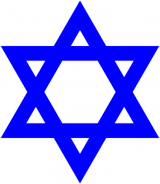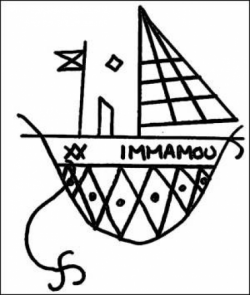What's the meaning of the Star of David »
Star of David
This page is about the meaning, origin and characteristic of the symbol, emblem, seal, sign, logo or flag: Star of David.

The Star of David, known in Hebrew as the Shield of David or Magen David (Hebrew מָגֵן דָּוִד; Biblical Hebrew Māḡēn Dāwīḏ [maːˈɣeːn daːˈwiːð], Tiberian [mɔˈɣen dɔˈvið], Modern Hebrew [maˈɡen daˈvid], Ashkenazi Hebrew and Yiddish Mogein Dovid [ˈmɔɡeɪn ˈdɔvid] or Mogen Dovid) is a generally recognized symbol of Jewish identity and Judaism. Its shape is that of a hexagram, the compound of two equilateral triangles. The hexagram has been in use as a symbol of Judaism since the 17th century, with precedents in the 14th to 16th centuries in Central Europe, where the Shield of David was partly used in conjunction with the Seal of Solomon (the hexagram) on Jewish flags. Its use probably derives from medieval (11th to 13th century) Jewish protective amulets (segulot).
The Jewish Encyclopedia cites a 12th-century Karaite document as the earliest Jewish literary source to mention the symbol. Its use as a symbol of the Jewish community dates to the 17th century. Pentagrams are also known to have been used as the Star of David dating from the Second Temple period. The Hebrew term for Shield of David (Magen) may be found in Psalm 3:3.
The hexagram does appear occasionally in Jewish contexts since antiquity, apparently as a decorative motif. For example, in Israel, there is a stone bearing a hexagram from the arch of a 3rd–4th century synagogue in the Galilee. Originally, the hexagram may have been employed as an architectural ornament on synagogues, as it is, for example, on the cathedrals of Brandenburg and Stendal, and on the Marktkirche at Hanover. A pentagram in this form is found on the ancient synagogue at Tell Hum. In the synagogues, perhaps, it was associated with the mezuzah.
The use of the hexagram in a Jewish context as a possibly meaningful symbol may occur as early as the 11th century, in the decoration of the carpet page of the famous Tanakh manuscript, the Leningrad Codex dated 1008. Similarly, the symbol illuminates a medieval Tanakh manuscript dated 1307 belonging to Rabbi Yosef bar Yehuda ben Marvas from Toledo, Spain. A Siddur dated 1512 from Prague displays a large hexagram on the cover with the phrase, "He will merit to bestow a bountiful gift on anyone who grasps the Shield of David."
- 1,275 Views
Graphical characteristics:
Symmetric, Closed shape, Colorful, Contains straight lines, Has crossing lines.
Category: Religious Symbols.
Star of David is part of the Jewish Symbols group.
More symbols in Jewish Symbols:
Jewish signs and symbols. read more »

More symbols in Religious Symbols:
Religious symbolism is the use of symbols, including archetypes, acts, artwork, events, or natural phenomena, by a religion. Religions view religious texts, rituals, and works of art as symbols of co… read more »
Citation
Use the citation below to add this symbol to your bibliography:
Style:MLAChicagoAPA
"Star of David." Symbols.com. STANDS4 LLC, 2025. Web. 22 Jan. 2025. <https://www.symbols.com/symbol/star-of-david>.


















Have a discussion about Star of David with the community:
Report Comment
We're doing our best to make sure our content is useful, accurate and safe.
If by any chance you spot an inappropriate comment while navigating through our website please use this form to let us know, and we'll take care of it shortly.
Attachment
You need to be logged in to favorite.
Log In